Marina Abramovic: Provocative performance artist turns 75
The artist has pushed her body and mind to the limits to evoke both human empathy and cruelty. Now 75, she is proud she helped bring performance art to the mainstream.
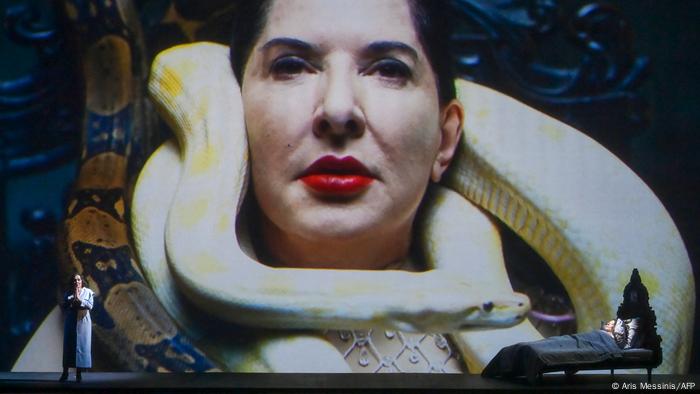
Her recent opera project debuted in 2020 in Munich and featured videos and opera scenes
Born in Belgrade, Serbia in 1946, Marina Abramovic studied art both in her hometown and in Zagreb, Croatia. Early on she developed an interest in performance art, including experiments with sound installations.
In 1973, the young artist was invited to Edinburgh, Scotland, for an international art festival, where she debuted her first provocative performance work.
Titled "Rhythm 10," Abramovic thrust ten sharp knives between her splayed fingers — a daredevil act in which she occasionally missed and drew blood. In Edinburgh, where the young artist and occasional painter met iconic German performance artist Joseph Beuys, she also realized she had found her medium.
"I had experienced absolute freedom — I had felt that my body was without boundaries, limitless; that pain didn't matter, that nothing mattered at all — and it all intoxicated me," recalled Abramovic of that first performance in her 2016 autobiography, "Walk Through Walls."
"I was drunk from the overwhelming energy that I'd received. That was the moment I knew that I had found my medium. No painting, no object that I could make, could ever give me that kind of feeling, and it was a feeling I knew I would have to seek out, again and again and again."
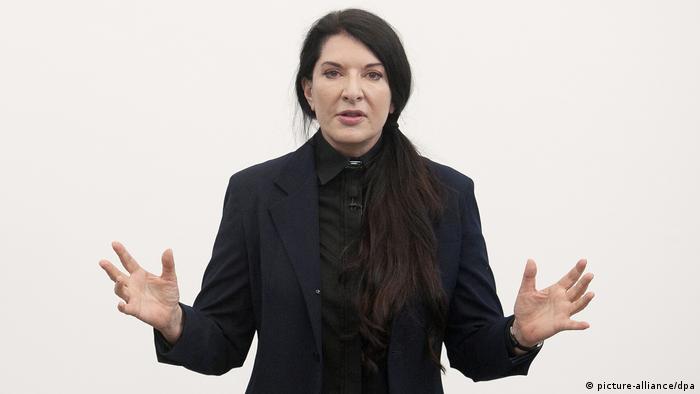
MARINA ABRAMOVIC: A LIFELONG PERFORMANCE
'Marina Abramovic. The Cleaner'
She laid naked on blocks of ice, cut herself and screamed until she lost her voice: Marina Abramovic used her body as a radical tool of expression like no other artist before her. A look back at the life and work. 123456789101112
Testing the limits
Abramovic has since carved a reputation as a pioneering performance artist who continues to test her physical and psychological limits.
Arguably her most provocative early work was 1974's "Rhythm 0," a performance in Italy, this time in Naples. In it, Abramovic directed the audience: "There are 72 objects on the table that one can use on me as desired."
The objects included razor blades, knives and a loaded gun. The artist sat motionless as people cut open her clothes or slashed her skin. "If you leave it up to the audience, they can kill," Abramovic said after the performance in which she sought to expose an inherent human cruelty.
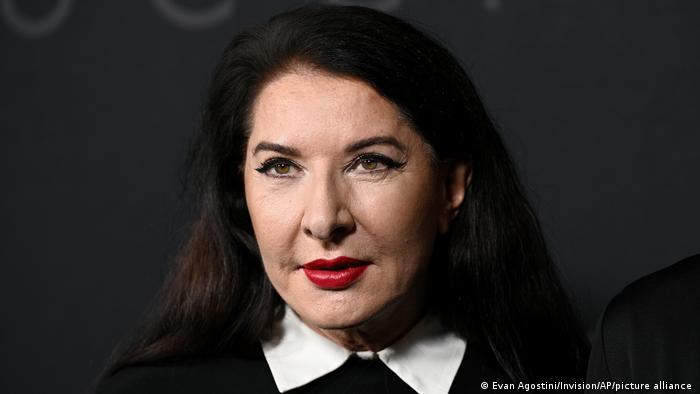
At age 75, the performance artist is not ready to retire
Earlier that year, her performance "Rhythm 5" included a burning communist star. She laid herself in the middle of it after cutting and burning her hair and nails. When the fire had consumed all the oxygen, Abramovic passed out.
This career path was soon taken in tandem with German artist Frank "Ulay" Uwe Laysiepen, who in 1976 became Abramovic's lover and collaborator for 12 years.
The 1977 performance "Imponderabilia" was typical of their oeuvre, Abramovic and Ulay stood at the entrance of a Bologna museum naked, forcing visitors to squeeze past them to enter.
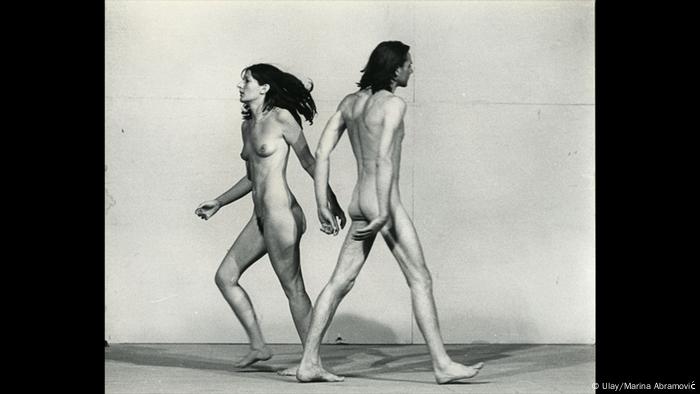
Marina Abramovic and Ulay perform "Relation in Space" in Venice in 1976
She and Ulay lived as free spirits in their small Citroen bus for four years, traveling through Europe and performing.
Even their separation in 1988 was sealed with an elaborate performance. In a piece titled "The Lovers," they walked towards each other along the Great Wall of China, starting at opposite ends and meeting in the middle. After covering some 4,000 kilometers (2485 miles), they said goodbye.
Balkan Baroque
The separation inspired the artist to break new ground. In 1997, she performed a work in the international section of the Venice Biennale titled "Balkan Baroque," a comment on the Yugoslav Wars, in which she spent seven hours a day washing a mountain of bloody cow bones. Her performance was awarded a Golden Lion.
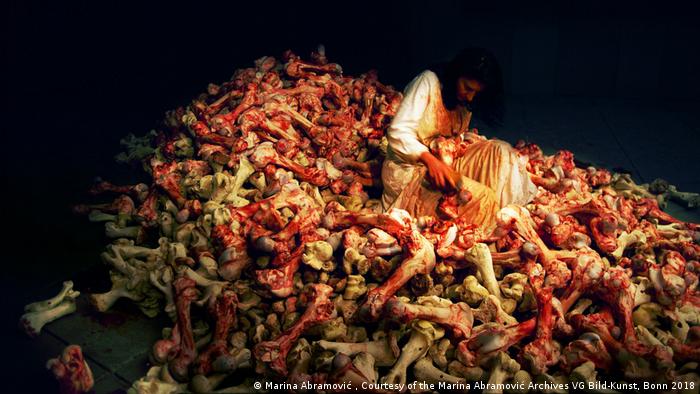
Marina Abramovic laid bare the horrors of the Yugoslav Wars in "Balkan Baroque"
Since the 1990s, she has also been teaching her "Abramovic Method" to young performance artists. She moved to New York in 2000, where she developed theater pieces, performances and encounters with other artists, despite some local reticence to her work.
In "House with the Ocean View," the artist spent 12 days in three open rooms in which she created an intimate relationship between herself and viewers.
The theme continued in a 2010 performance at New York's Museum of Modern Art (MoMA), "The Artist is Present," in which she locked eyes with audience members at a table from a wooden stool in which she sat for seven hours a day for 75 days — stars like Sharon Stone, Tilda Swinton, Björk and Lady Gaga made use of the chair.
Former lover Ulay, who she had not spoken to in years, famously showed up without warning and stared across at the star artist. They both cried.
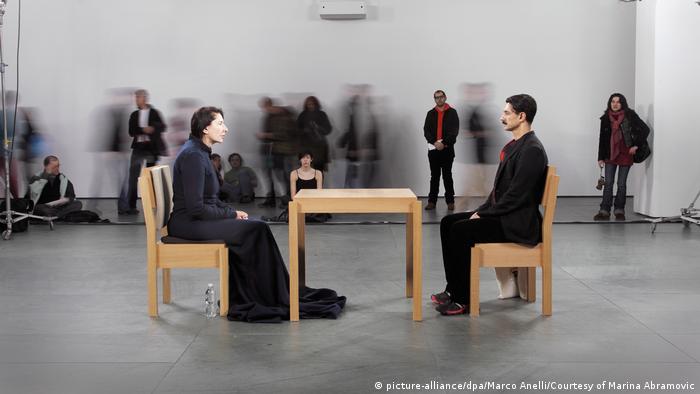
Performing "The Artist is Present" in 2010, at the Museum of Modern Art New York
Deciding to be happy
In the decade since, her works have been characterized less by violence and more by asceticism and recollection. Her method is based on a mix of various esoteric and eastern relaxation and meditation exercises. She spends every year's end in a monastery in India to meditate and recharge her batteries. "We have to create situations where our bodies are healthy and function well," she said.
The Serbian artist has been accused of trying to evolve from artist to shaman, though she has also suffered much worse throughout a provocative career. In 2018, for instance, she was attacked with a portrait of herself while she held a book signing for, "Marina Abramovic Interviews 1976-2018," in Florence, Italy. After the incident, she returned to her hometown of Belgrade to kick off her retrospective "The Cleaner."
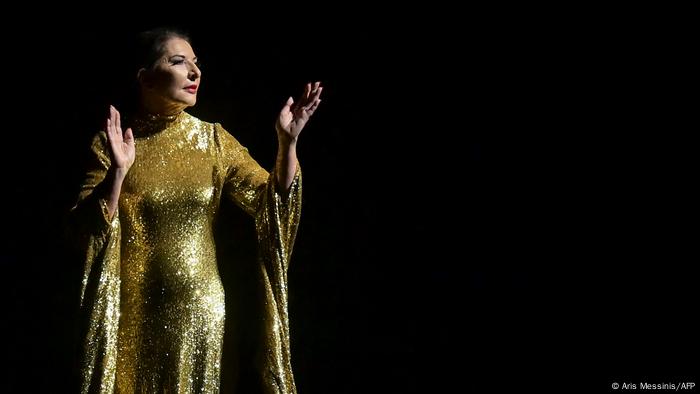
The artist performed "7 Deaths of Maria Callas" in September 2021, at the Greek National Opera
In 2020, the artist debuted the operatic project, "7 Deaths of Maria Callas," at Munich's Bayerische Staatsoper. In it, she re-enacted seven of Callas' most famous on-stage deaths. "Like many of the opera heroines she created on stage, she, too, died of love. She died of a broken heart," said Abramovic of the star — whom she greatly admired.
When considering her own legacy this November, Abramovic told Interview Magazine, "I really think that one important thing is that I am one of the people responsible for making performance art into mainstream art."
"You need night to understand yourself," Abramovic told DW on the occasion of her 70th birthday. "Getting older means getting wiser," she added. "You know that you're going to the last part of your life and that you have to concentrate on the most important things. And I've decided to be happy."
Edited by: Sarah Hucal
No comments:
Post a Comment